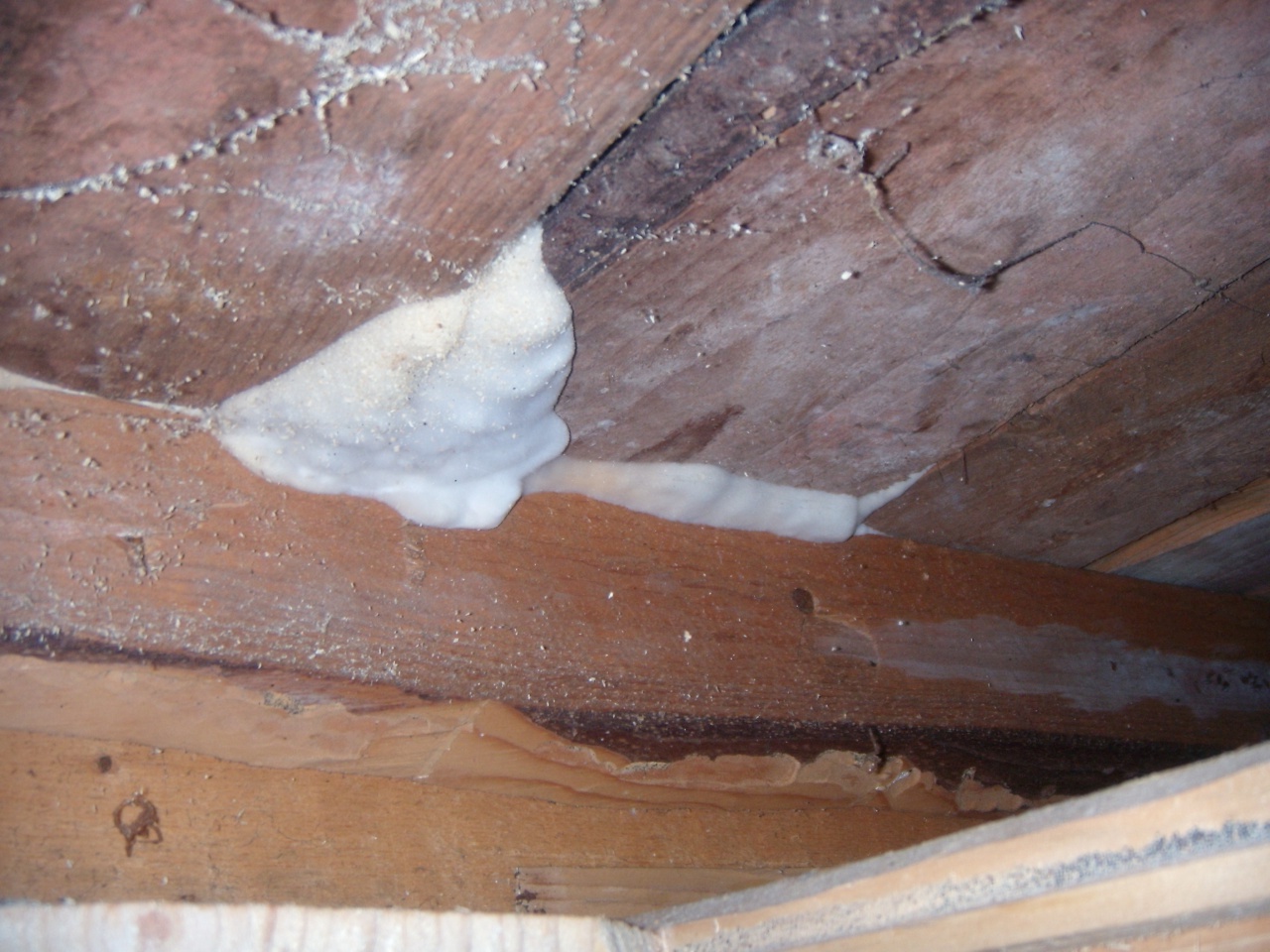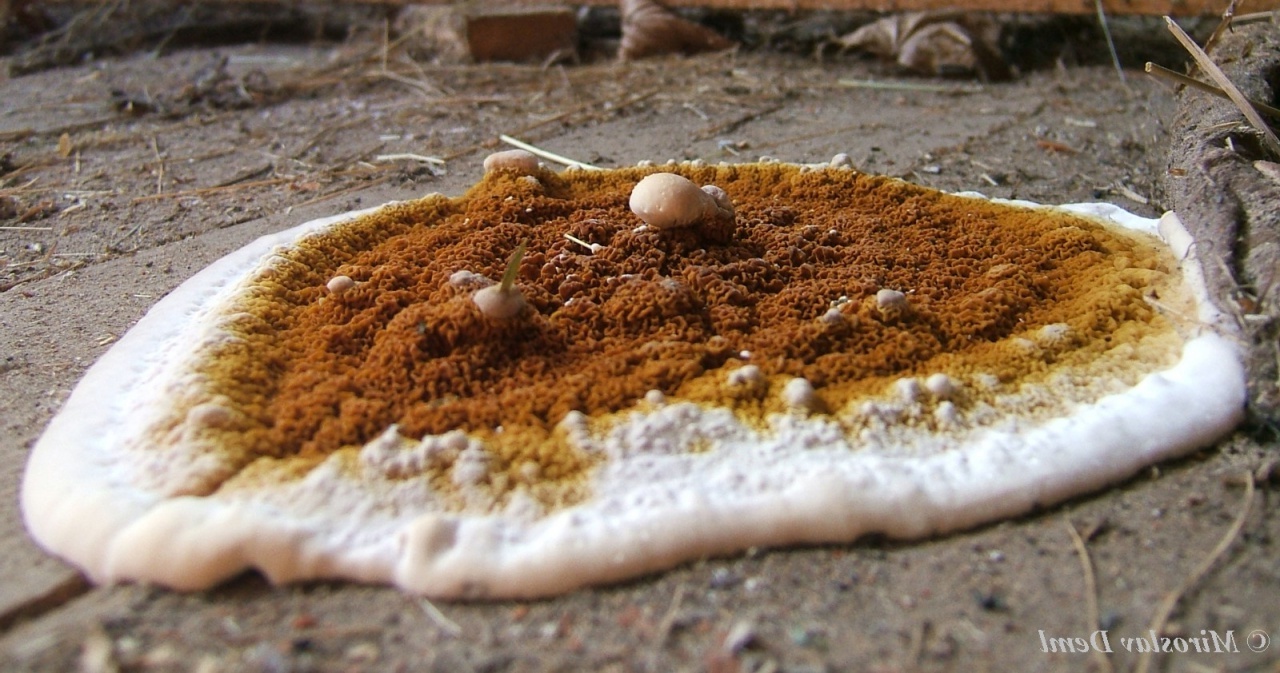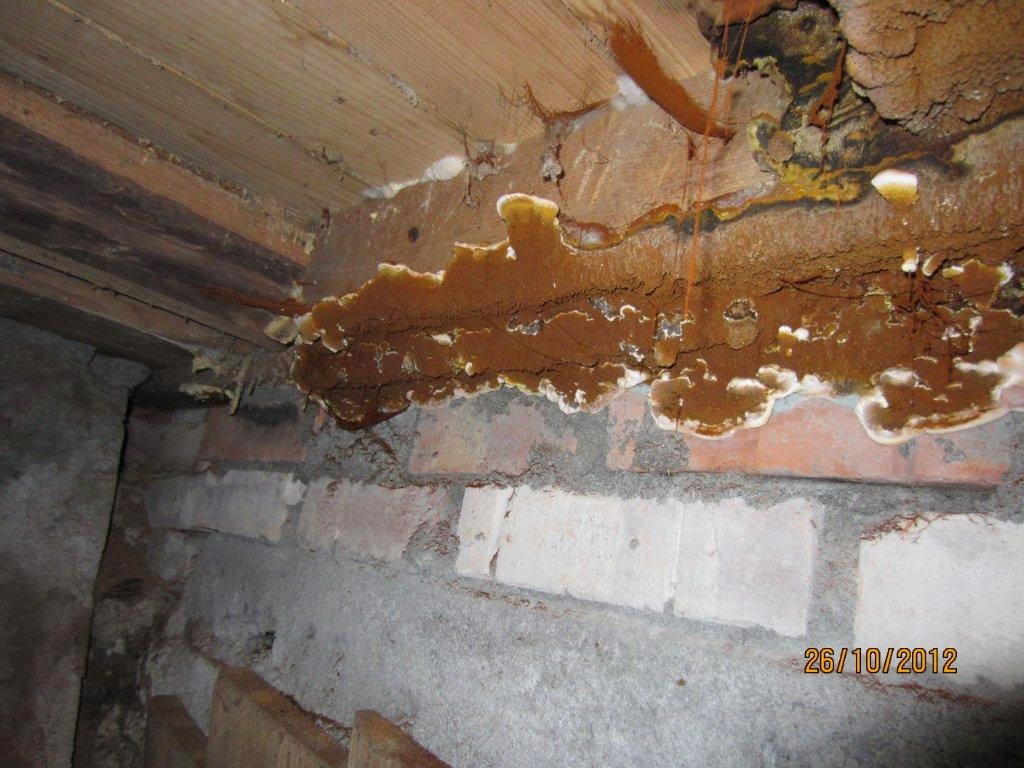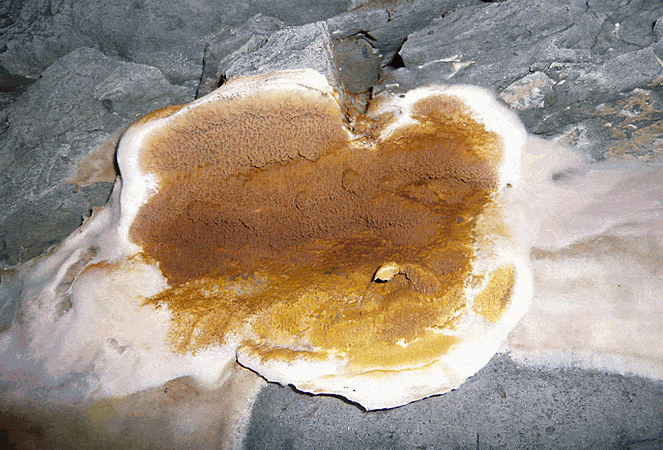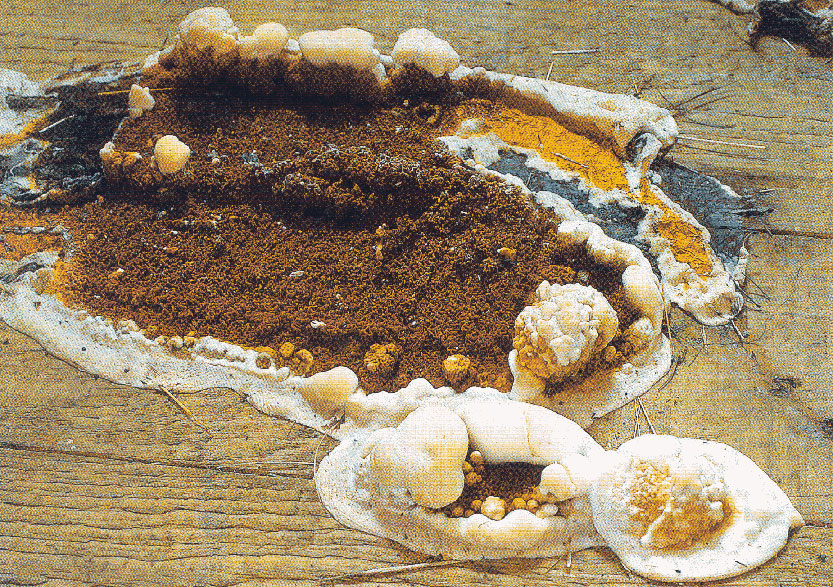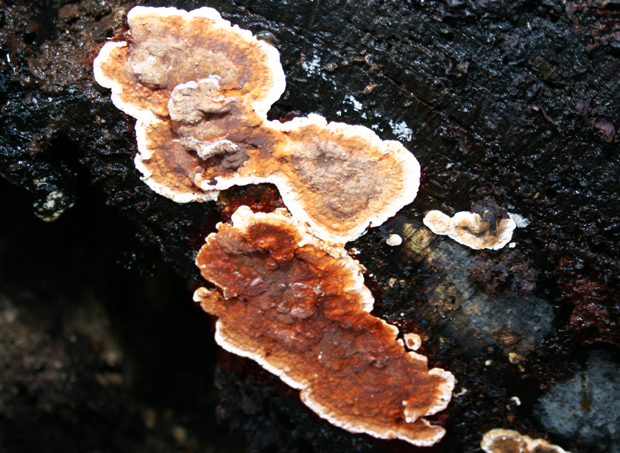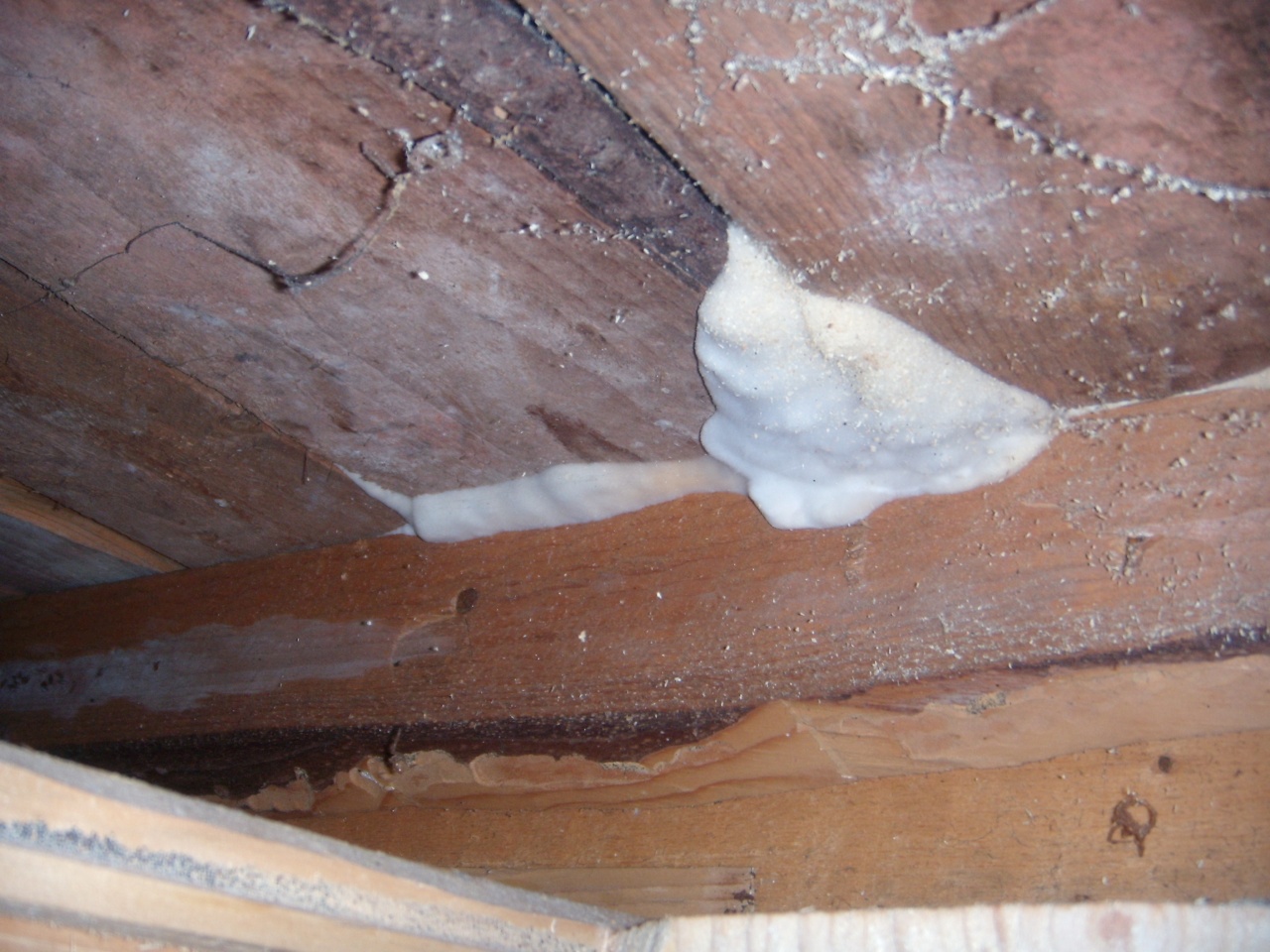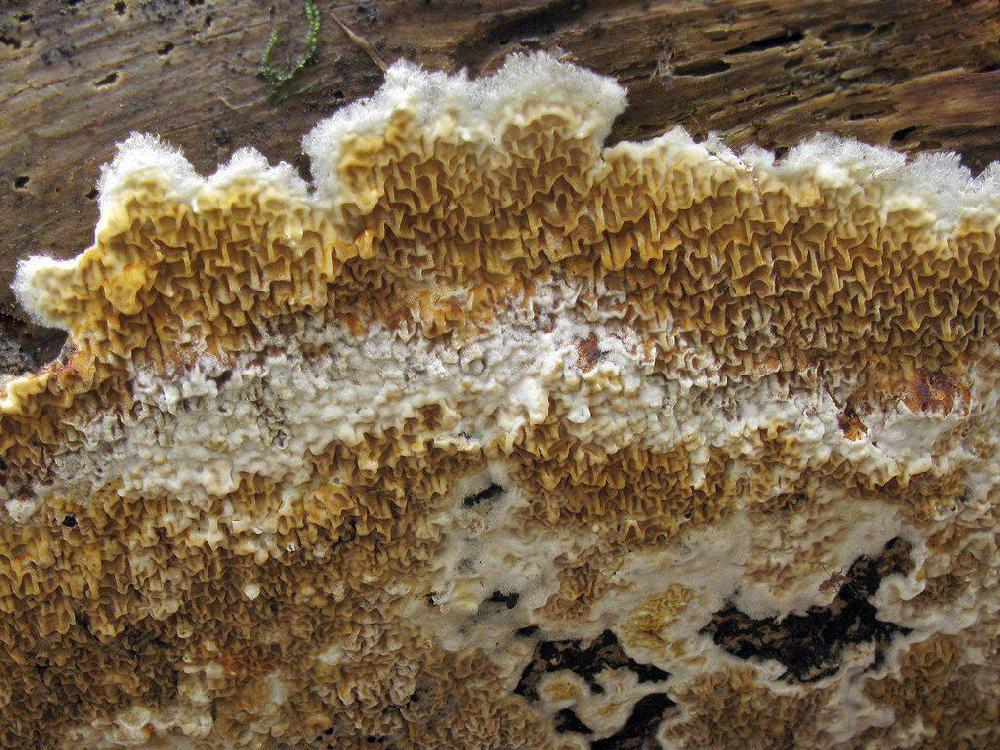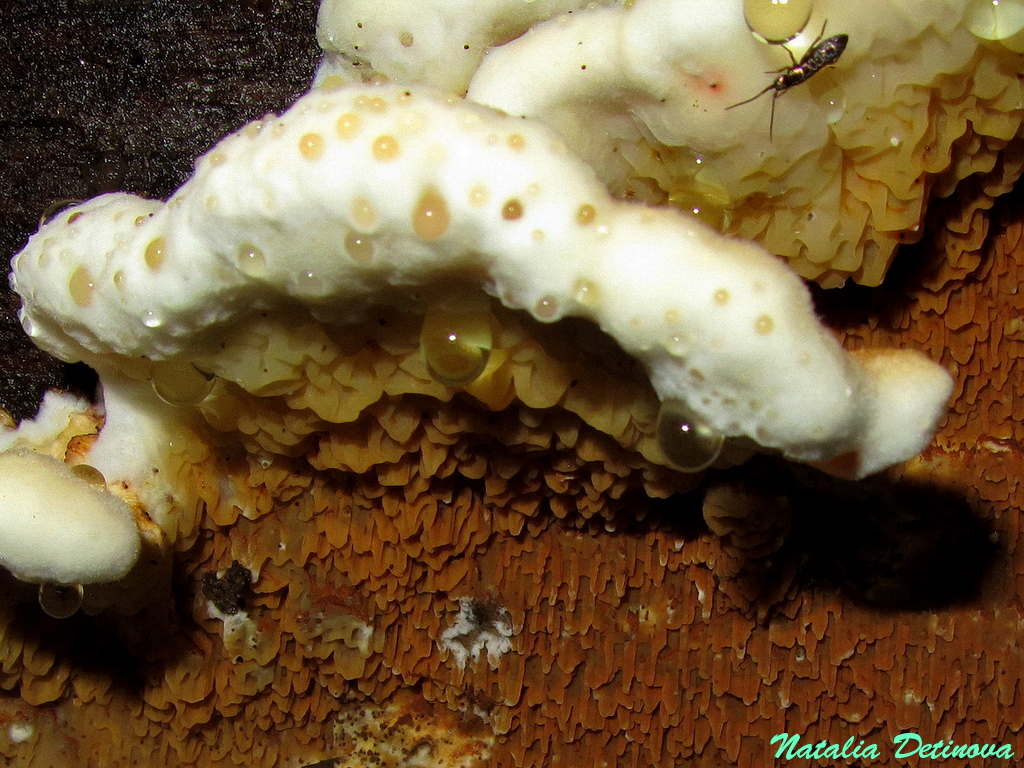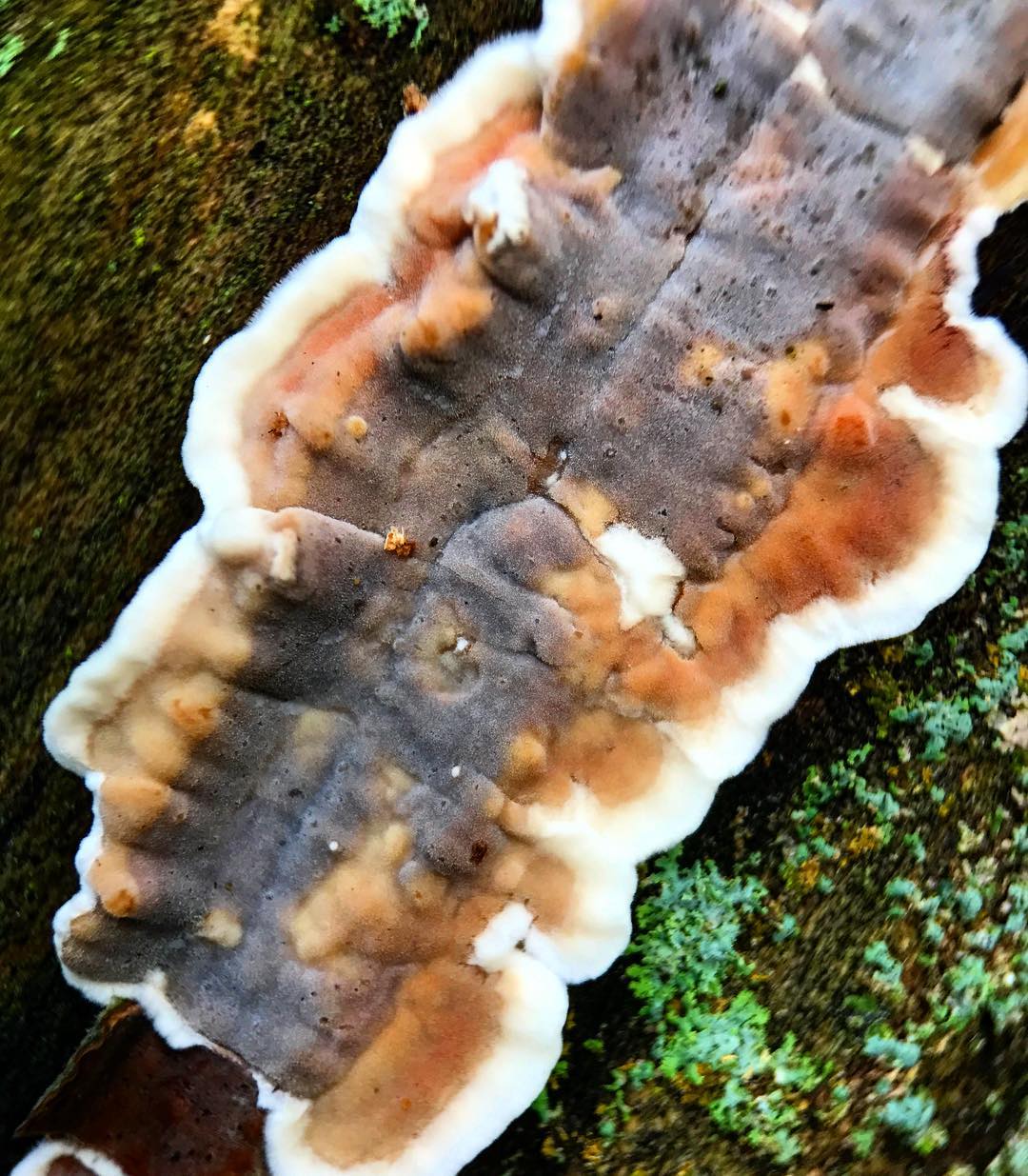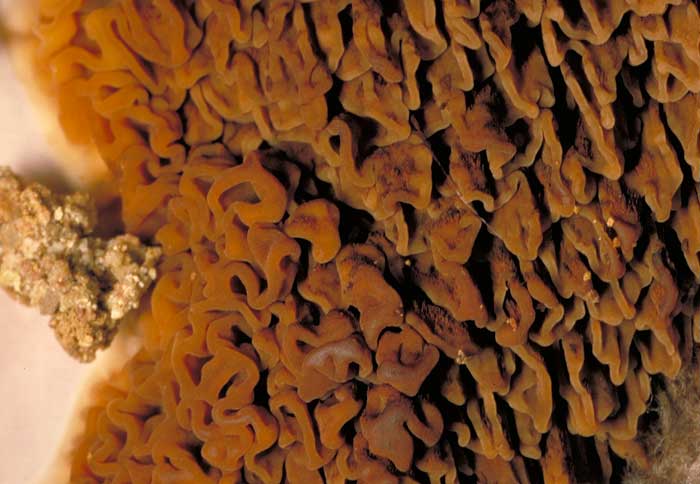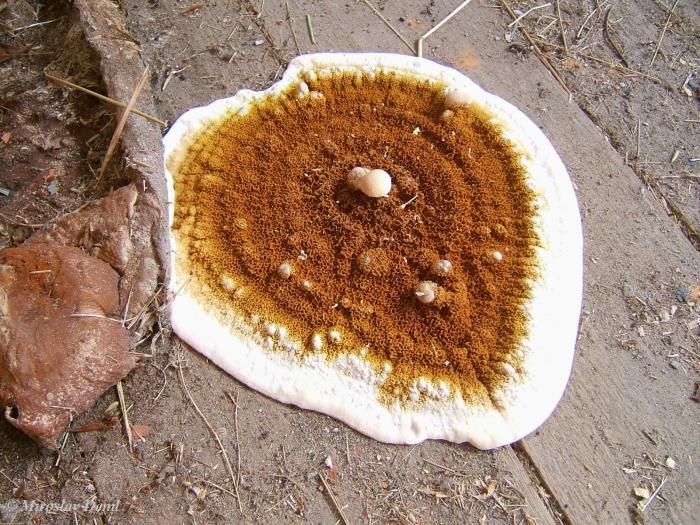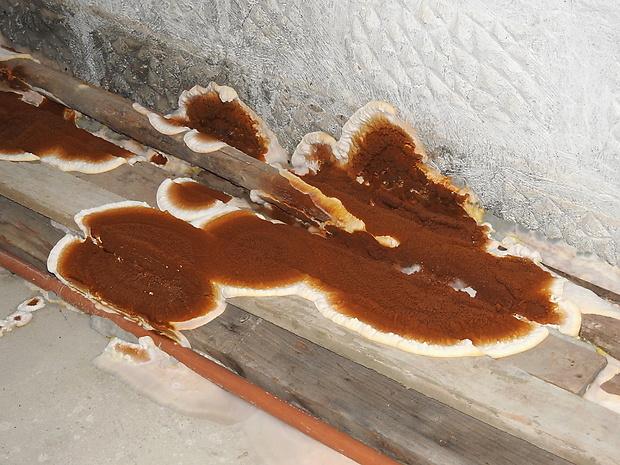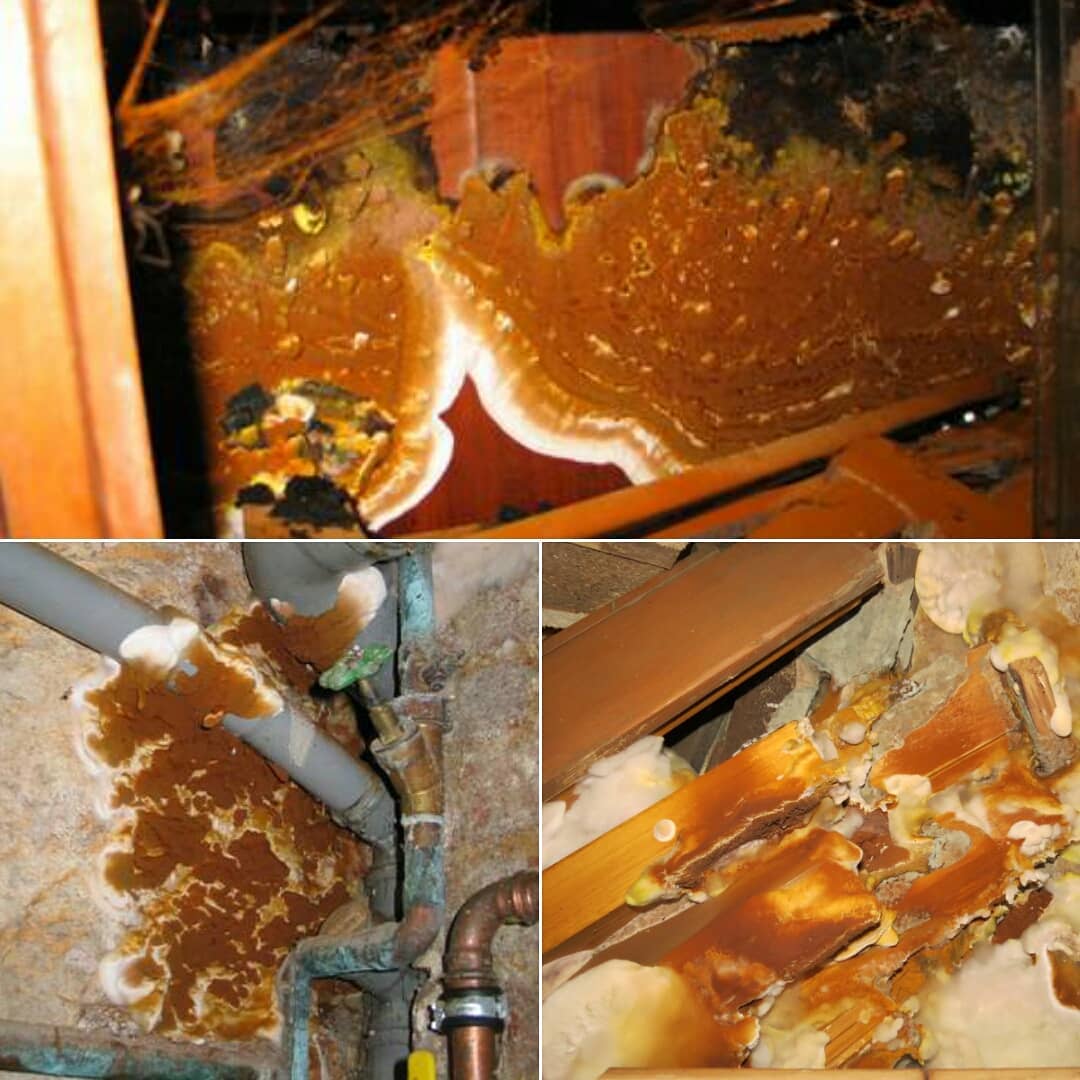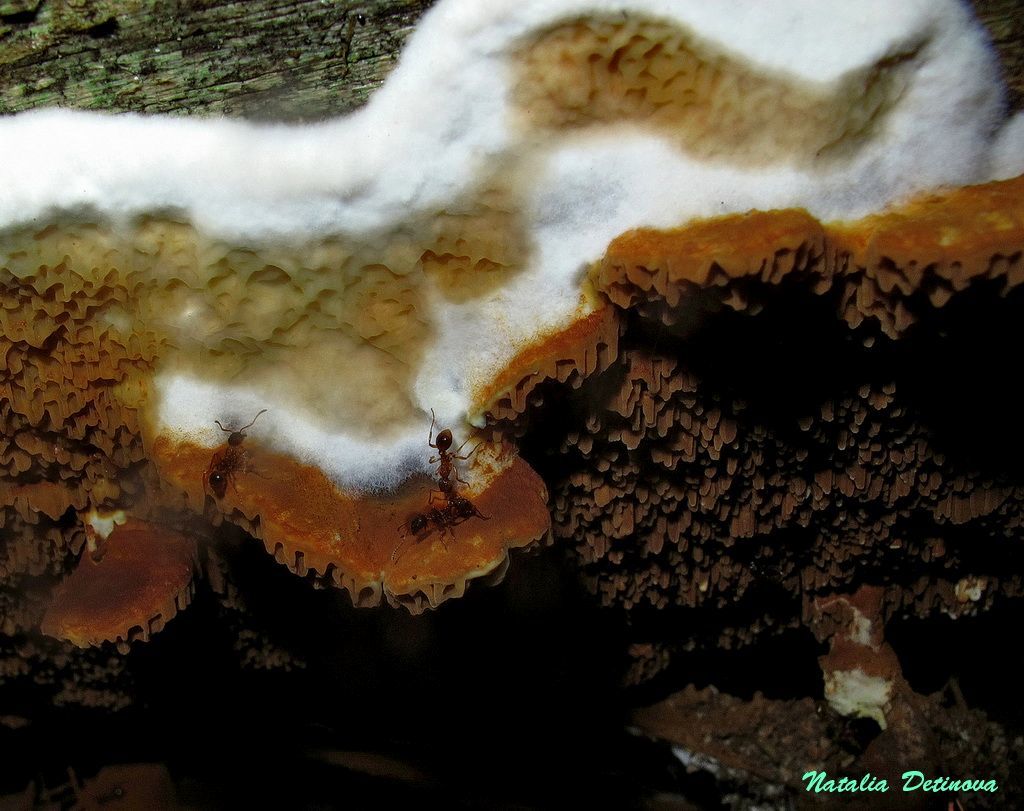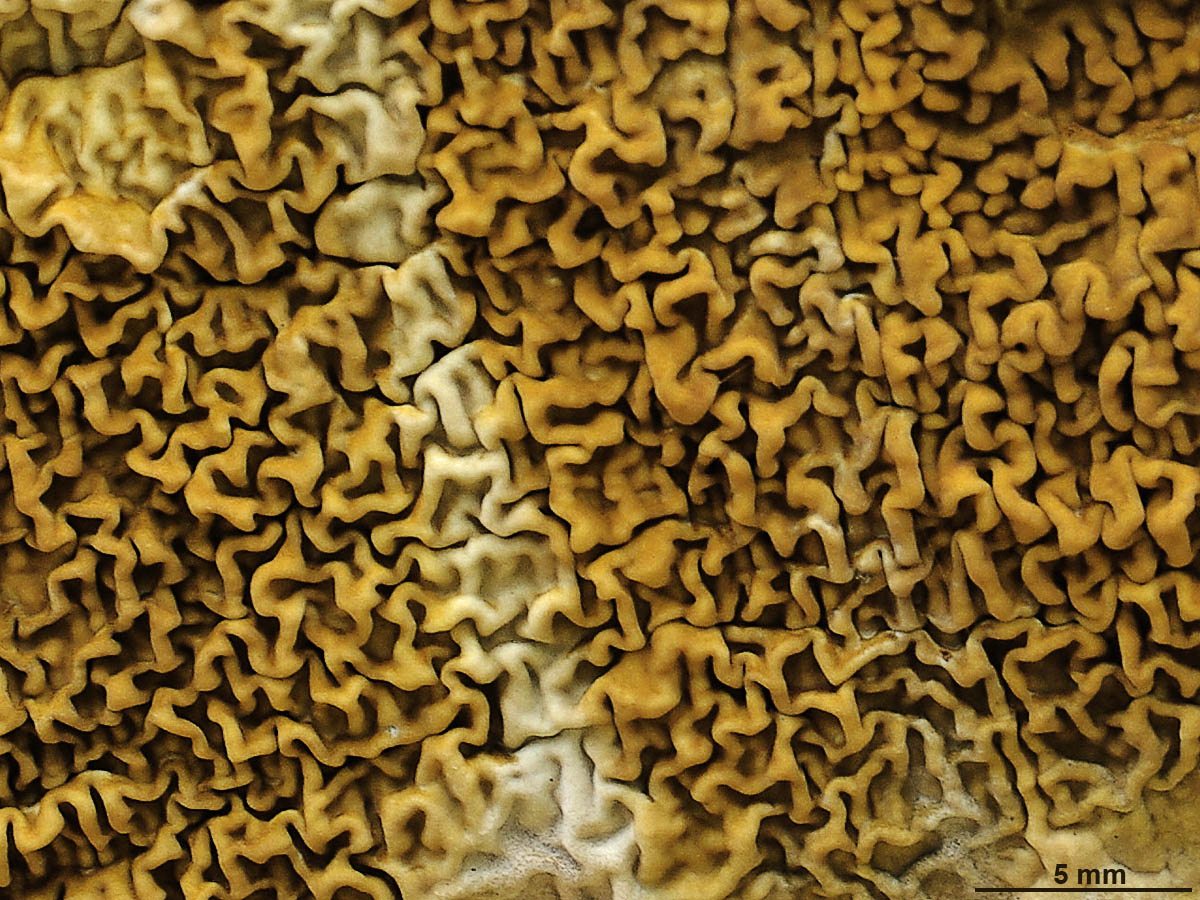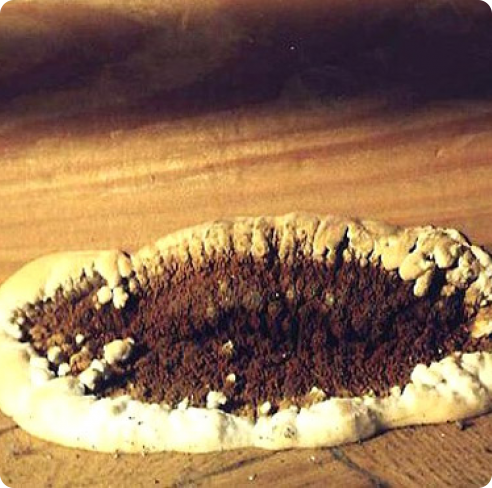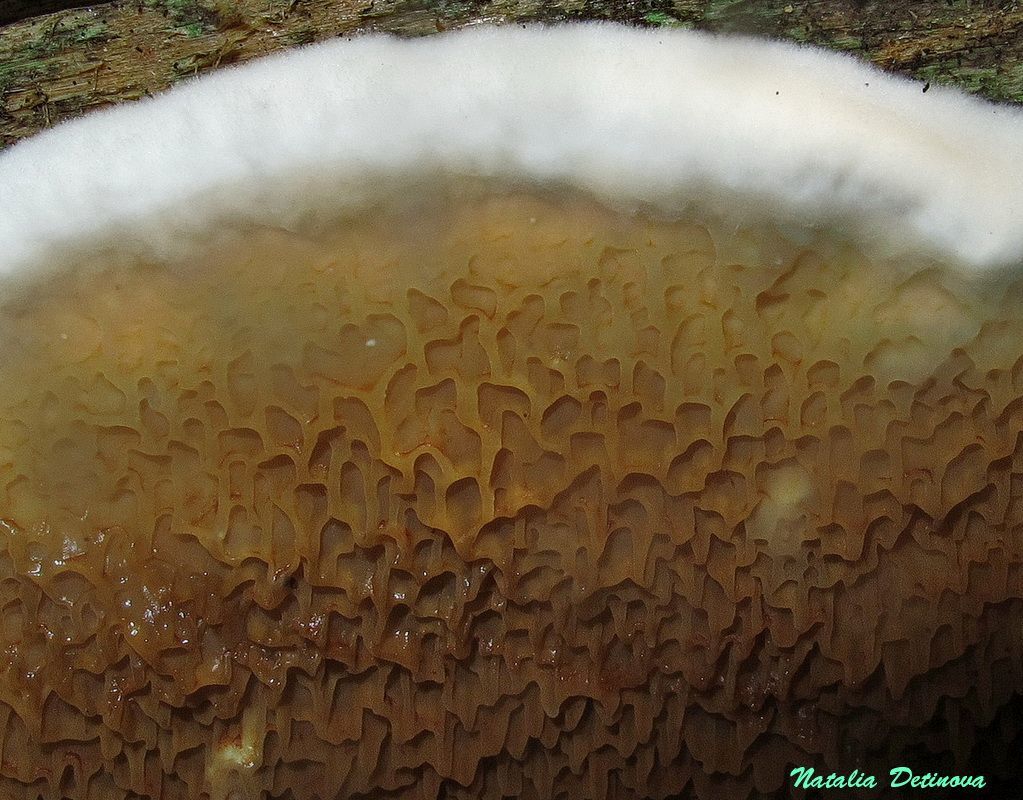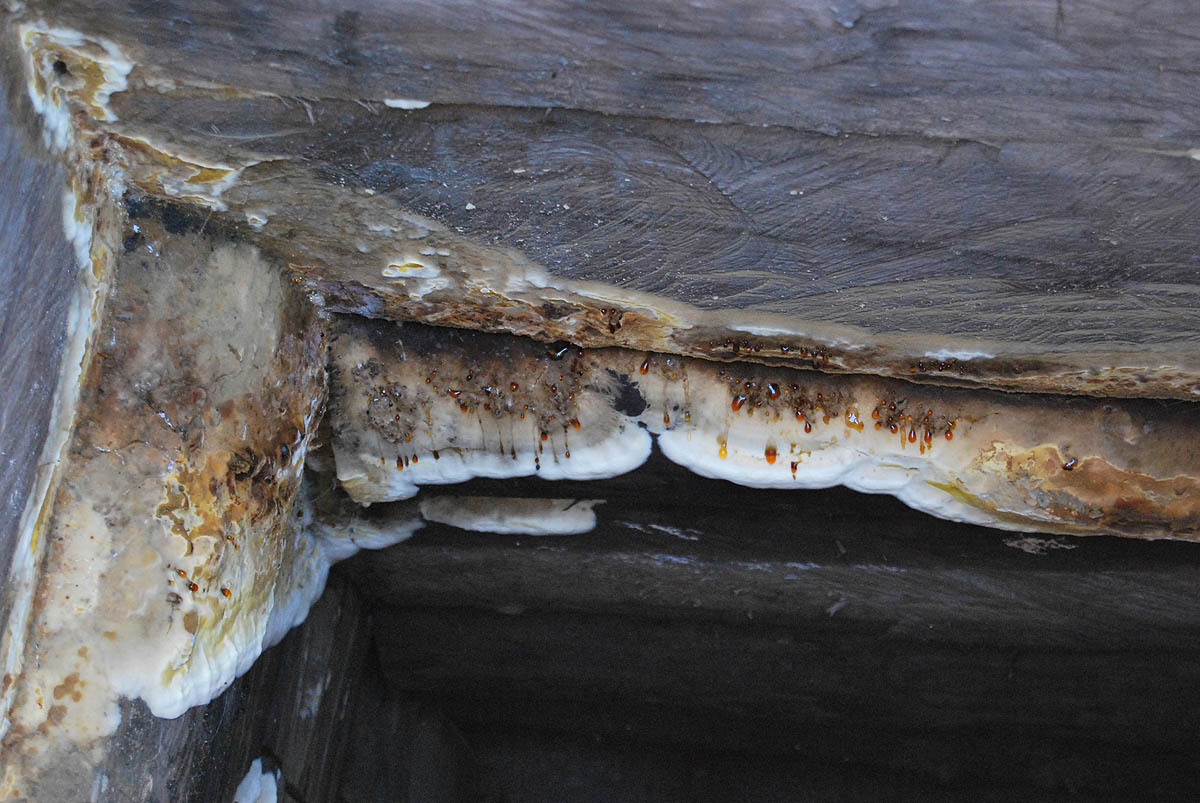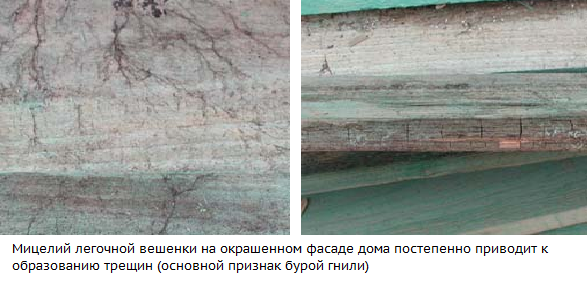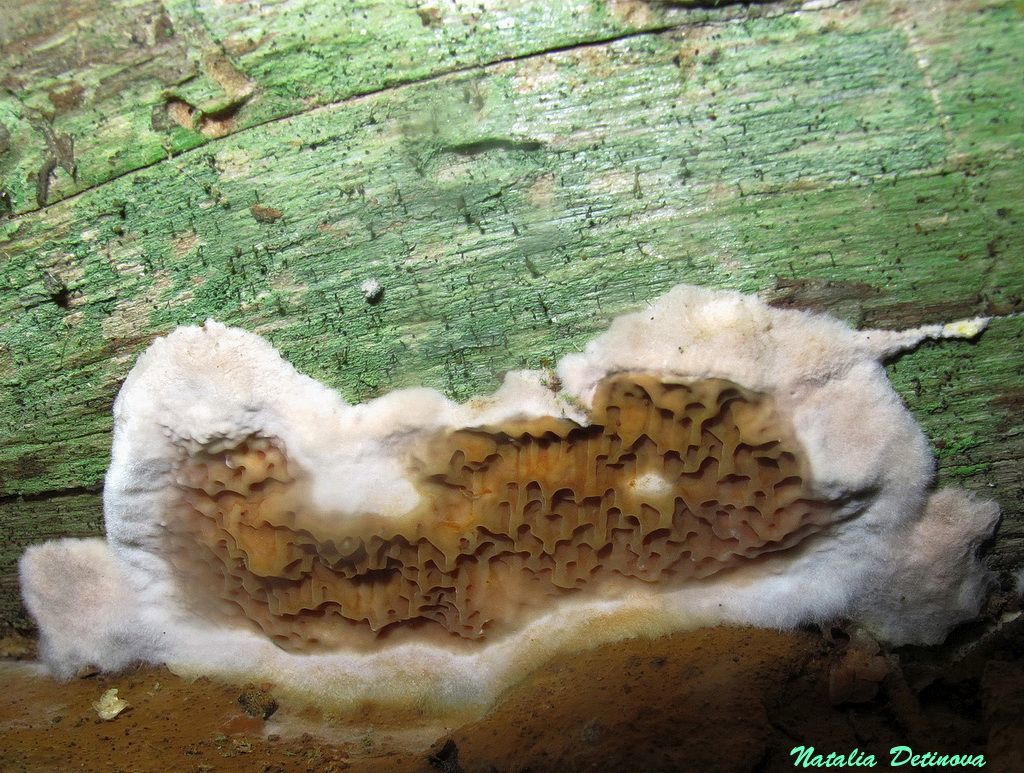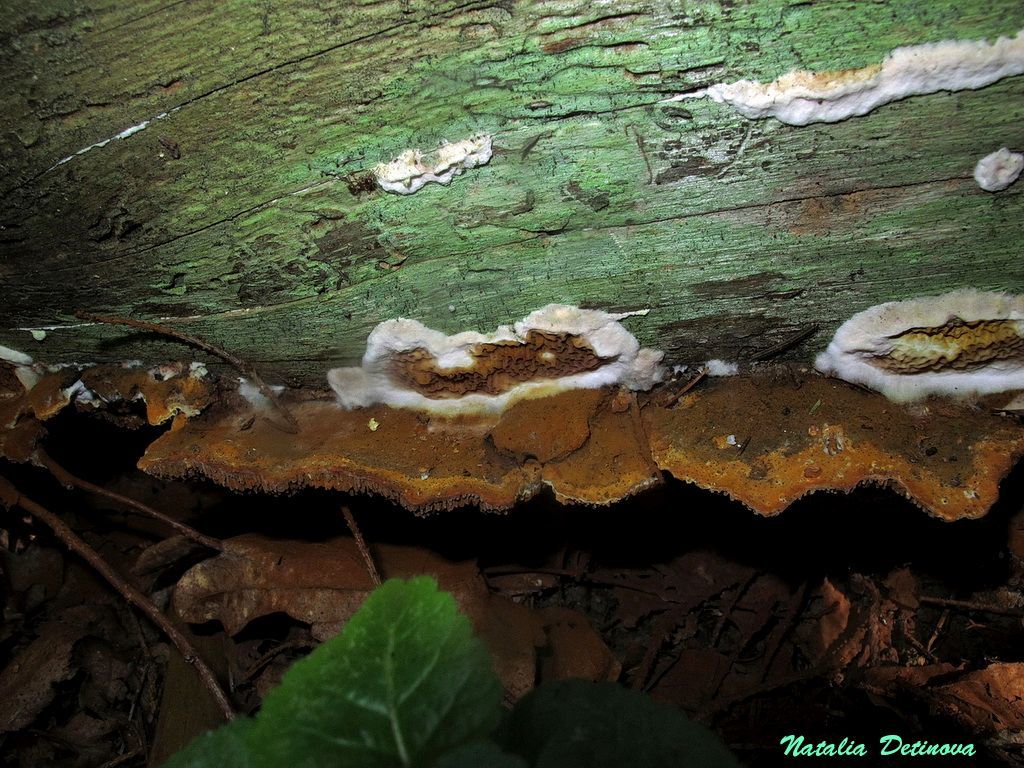House mushroom (Serpula lacrymans)
Hide ads in article
HOUSE MUSHROOM (Serpula lacrymans)
the most harmful of all the mushroom houses and the most common in the territory of the former USSR. It is found from the Baltics to Kamchatka, and is known in Western Europe and North America.
A real house mushroom is one of the few types of mushrooms that are found only in buildings and are not observed in nature. The fungus infects mainly the wooden parts of the lower floor and basement: floors, walls up to a height of about 1 m. The first signs of infection are a musty smell in the premises, non-drying, wet spots on the wall, and then loose floor boards. When opening the floor, you can find cotton-like accumulations of fungal mycelium, mushroom strings and films. At first they are white, and then with a characteristic yellowish, pinkish, purple and gray tint. Some of the wood has already completely rotted, some have turned brown and become soft.
Rot spreads very quickly in wood; this is facilitated by the growth of mushroom laces and films on the surface of infected wood. It takes up to a year, and sometimes even six months, to completely decay a floor or a beam. On the lower surface of rotten wood, fleshy-scarious fruit bodies are formed, which can reach significant sizes, up to several meters long. In damp rooms, fruit bodies also appear in the lower part of the walls inside the room, at the base of jambs, etc. The presence of such fruit bodies visible inside the room itself is a sign of widespread and severe damage to wooden structures.
On the fruit bodies, basidiospores of the fungus are formed in mass quantities, which are sometimes visible as brown dust on the floor or in the corners of the room. On 1 cm2 of the surface of the fruiting body, up to 35 million spores can be released during the day; the most intense sporulation in spring and in the first half of summer.
Spores of a real house mushroom are very light. In 1 m3 of air in a contaminated room, there are up to 2.5 million spores. They are carried even by small air movements; in the air of any city or village, there are almost always spores of a real house mushroom. Spores can be accidentally transferred to people's shoes and clothing. Especially dangerous are boards infected with fungus and other rotten wood residues, which, during repairs, are often thrown into the yard or even brought as fuel to uninfected houses.
For germination and further infection of wood, spores require certain conditions. This is primarily the high moisture content of wood and ambient air. The most intense decay is observed at an air humidity of 90–95% and a temperature of 18–23 ° C. Such conditions can arise from improper construction of a building, when the insulation of wooden structures from the foundation is not well laid. The accumulation of condensation moisture is often observed, for example near water pipes; rain or melt water getting into basements, under walls. Many simple wooden buildings in Siberia and in the north of the Far East are built with a plinth, which serves to insulate the lower part of the building. If water (rain) gets into the filler of the basement, then infection with house mushrooms is almost inevitable.
The second group of causes of infection is negligence in the operation of houses. Untimely roof repairs, faulty ventilation in damp rooms, leaking water pipes and other shortcomings in maintenance will lead to a constant accumulation of dampness and, at the same time, conditions are created that are favorable for the development of house mushrooms. If buildings are infected with a mushroom house, urgent repairs are needed. Being late for repairs, even only for a month or two, can increase losses several times.
When repairing, wooden structures contaminated with fungus should be completely removed.The initial stage of the development of rot is invisible to the naked eye, therefore, it is necessary to remove apparently healthy boards bordering on clearly rotten ones: along the grain of the wood up to 0.5 m, and across the fibers at least 20 cm. The top layer under the infected floor must also be carefully removed: mushroom can persist for a long time and develop in the form of mycelium in wet soil or even in sand, if there is an admixture of sawdust or humus.
Infected constructions should be replaced with new ones made of dry antiseptic wood or rotten material. The new floor must not be immediately covered with a dense covering (linoleum, relin and other synthetic materials), which prevents the floor from drying. But the main thing during the repair is to find and eliminate the reasons that favored the development of the house fungus, creating the conditions necessary for its development (dampness, accumulation of moisture).
Honey mushrooms
Rarely on buildings, and more often around them, there is an amazing kind of coal-black mycelium that lives on non-living trees. We are talking about autumn mushrooms
(Armillaria), which are the most important root rot pathogens. Growing on fallen trunks, rotten stumps and other woody debris, the mycelium of this fungus grows through the ground and forms white rot.
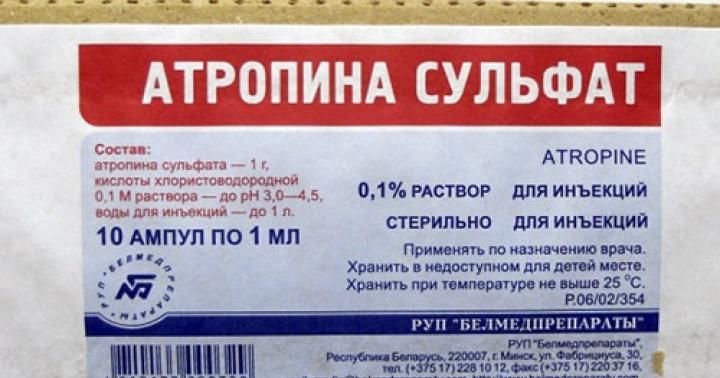
Due to its anomalous mycelium, honey fungus is probably the largest and oldest living thing on the planet.
The appearance of fungus on wooden structures always upsets and upsets households. However, if you do not attach importance to this, then soon it will become not only a reason for a bad mood, but also the cause of the destruction of products even from the most durable varieties of wood, and most importantly - a source of dangerous diseases. to begin with, figure out what exactly you are faced with: a basement fungus, a house sponge or a white house fungus. You can detect the enemy with the naked eye. White and yellow spots on wood surfaces that darken to brown and black over time indicate that a cellar mushroom has settled in your room. A house sponge covers the wood with a white layer, similar to a wool blanket, and can grow up to 10 m. A white house fungus leaves a similar white porous pillow. You should insure yourself against this misfortune even at the construction stage. Never build with damp, poorly dried, or used wood. Impregnation of wooden elements with special oils and preparations, such as, for example, creazote, will perfectly serve as a prevention against fungus. If, despite all your efforts, you still encounter this problem, then the best way to solve it is to completely replace the parts of structures damaged by the fungus ... However, such a radical method is not always available and easy. An alternative can be scraping the fungus from the affected area and treating the surface with a special solution based on copper or iron sulfate. Here are several types of solutions and mixtures that can give the maximum effect in the fight against house fungus: a liter of water, 50 g of vitriol, clay; 10 liters of water, 500 g of vitriol, 2 tablespoons of vinegar; liter of water, 100 g of sodium fluoride; You can, of course, find ready-made mixtures to destroy the fungus. In any case, they can be applied either by spraying or using a brush, just in case, repeat the treatment after a month. Do not forget to regularly ventilate the premises and periodically repaint the wooden structural elements and the house fungus will no longer bother you.
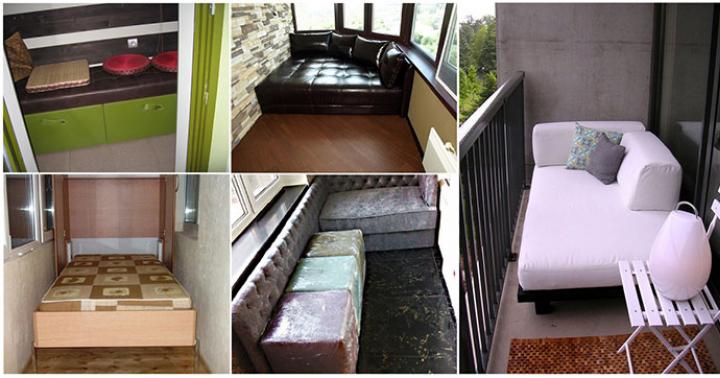

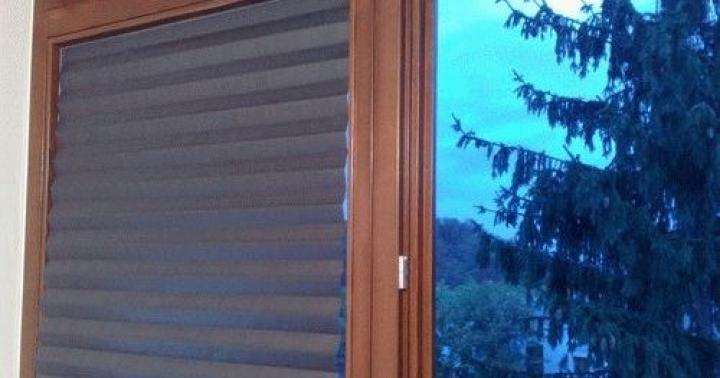
The mushroom house is a pest that destroys the wooden elements of the house. In 1 month, he can turn a four-centimeter oak floor into dust, and in six months he can completely destroy a house. An unpleasant smell resulting from the rotting of an obsolete fungus is harmful to health. Its rapidly spreading spores can cause headaches, conjunctivitis, laryngitis, allergies, and exacerbation of asthma.And also, being a good conductor of water, this pest can make the room damp and uninhabitable.
In view of such a serious danger, pay attention to how to recognize a mushroom house in time, how to prevent it from appearing in your house and, finally, if you find it, how to get rid of it.
Separate childbirth
Pecten sp. with serpulid worm encrusters; Duck Harbor Beach at Cape Cod Bay, Wellfleet, Massachusetts.
- Amplaria Knight-Jones, 1973
- Anomalorbis Vine, 1972
- Apomatus Filippova, 1844
- Bushiella Knight-Jones, 1973
- Capeospira Pillai, 1970
- Chitinopoma Levinsen, 1884
- Circeis Saint-Joseph, 1894
- Crucigera Benedict, 1887
- Dexiospira Caullery and Mesnil, 1897
- Dextralia Knight-Jones, 1973
- Ditrupa Berkeley, 1835
- Eulaeospira Pillai, 1970
- Ficopomatus Sauthern, 1921
- Filograna Berkeley, 1835
- Filogranella Ben-Eliyahu and Daphne, 1979
- Filogranula Langerhans, 1884
- Galeolaria Lamarck, JB - de (1818)
- Hyalopotamus Marenzeller, 1878
- Hydroides Gunnerus, 1768
- Janua Saint-Joseph, 1894
- Josephella Caullery and Mesnil, 1896
- Leodora Saint-Joseph, 1894
- Metavermilia Bush, 1904
- Neodexiospira Pillai, 1970
- Neovermila day, 1961
- Nidificaria
- Paradexiospira Caullery and Mesnil, 1897
- Paralaeospira Caullery and Mesnil, 1897
- Pileolaria Claparede, 1870
- Placostegus Filippova, 1844
- Pomatoceros Filippova, 1844
- Pomatoleios Pixell, 1912
- Pomatostegus Schmarda, 1861
- Protolaeospira Pixell, 1912
- Protula Risso, 1826
- Pseudochitinopoma Zibrowius, 1969
- Pseudovermilia Bush, 1907
- Salmacina Claparede, 1870
- Semivermila Imajima, 1978
- Serpula Linnaeus, 1767 Genus type
- Simplicaria Knight-Jones, 1973
- Spirobranchus Blainville, 1818
- Spirorbis Daudin, 1800
- Turbocavus Prentice et al., 2014
- Vermiliopsis Saint-Joseph, 1894
- Vinearia
-
Ficopomatus enigmaticus
-
Filograna implexa
-
Protula bispiralis
-
Serpula vermicularis
-
Spirobranchus giganteus
-
Spirorbis sp.
Habitat [| code]
The mushroom house has a high degree of ability, characteristic of mushrooms in general, to develop an abundant mycelium in conditions that are not conducive to fruiting. Such conditions are humidity, stale, stagnant air and lack of light. Under these conditions, the fungus quickly and abundantly develops in a sterile form (it was previously called Himantia link) and vigorously pursues the deed of destruction.
Most often, the fungus develops in dark, stuffy and damp cellars and basements, at the base of beams, on the lower surface of floor boards, directly resting on moist soil.
At first, only small white dots are seen on the tree, gradually merging into slimy spots or soft woolly deposits; then a silvery web-like plexus is formed. It grows more and more and spreads over the surface of the tree, becomes thicker, leafy and takes on an ash-gray color and a silky sheen.
From the edges of the mushroom, thin threads extend into spurs, crawling in search of food through the smallest holes and cracks in the stone walls from one part of the house to another. In some cases, the destructive work of the fungus can cause the entire house to fall.
Sometimes other mushrooms come to the aid of D. mushrooms: lat. Polyporus vaporarius, lat. Polyporus destructor and others.
The mushroom house attacks mainly conifers, but deciduous ones (for example, oak) are not immune from it.
Recommendations
- Citation
- general
| Wikimedia Commons has media related to serpulids . |
- Abbott, R. Tucker (1986). Seashells of North America ... Press Martin.
- ten Hove, GC; van den Hurk, P. (1993). "An overview of modern and fossil serpulid 'reefs', actuopalaeontology and serpulid limestones 'upper Malm' in northwest Germany." Geologie en Mijnbouw . 72 (1): 23-67.
- Ruppert, Edward E .; Fox, Richard S. & Barnes, Robert D. (2004). Invertebrate Zoology: A Functional Evolutionary Approach (7th ed.). Belmont, CA: Brooks / Cole - Thomson Learning Inc. ISBN 0-03-025982-7.
Weeping sickle, Serpula lacrymans

Fruit body: Quite shapeless and ugly, outstretched (on a horizontal surface) or flowing, drop-like (on a vertical), in rare cases, as if trying (unsuccessfully) to take the traditional "hoof-like" tinder shape; size from 10 to 30 cm, despite the fact that several fruiting bodies can merge into a homogeneous mass, forming a global fruiting body. Young specimens of white color, look like drip formations in the gap between the logs (like a sulfur-yellow tinder fungus, Laetiporus sulphureus, only the color is different), then a brown, lumpy, unevenly tubular hymenophore forms in the middle part, producing separate outgrowths, like small fruit bodies with a white edge and a brown core. On the edges of the mushroom, you can often find drops of liquid, thanks to which the weeping sickle has earned such a name. The pulp is soft, loose, of a cottony consistency. The smell is heavy, reminiscent of damp excavated earth.
Hymenophore: Tubular-labyrinthine, extremely irregular - it can be called tubular with a great deal of convention. It is located either in the center of the fruiting body (if it is flattened horizontally), or wherever possible.
Spore powder: Brown.
Distribution: Occurs in poorly ventilated wooden buildings throughout the warm season (in heated rooms all year round). Destroys any wood with great speed. A characteristic sign of the presence of a mushroom house is a thin layer of reddish-brown spore powder on all surfaces, forming before the plank floor begins to fall.
Similar species: Serpula lacrymans is a unique mushroom. Adult specimens cannot be confused with anything.
Edible: God forbid.
Author's notes: The weeping sickle is a mushroom house that bursts into crocodile tears. The weeping sickle is the only truly disgusting, ugly mushroom. A lot more bad things can be said about the crying sickle. However, this is not the place to talk badly about mushrooms, so I will try to show my admiration. Serpula lacrymans secretes a huge amount of spores: even when all the fruit bodies that were within reach are destroyed at the root, everything in the house is covered with a layer of brown powder in a matter of hours. Serpula eats everything and is not afraid of anything: in a few months she has mastered new floorboards, treated with some kind of fungicide, you know. Serpula bitterly mourns the plywood frame of the sofa, which is about 70 years old. Serpula is interested in book knowledge, willingly gets acquainted with periodicals. In the house where the weeping sickle lives, it is scary to remain motionless: you never know what her tears will be shed over tomorrow.
Interesting Facts
The defeat of wood with a house fungus means its final coming into disrepair. Such material cannot be reused, otherwise the contamination will spread to clean boards. To avoid this, the affected wood is burned, and all working tools in contact with it are thoroughly cleaned. The use of quartz irradiation is considered to be protection against the fungus. Special impregnations can also be used, but they are quite toxic, which limits their use in residential premises.
serpulids Time range: Perm-0PreЄЄOSDСпTJКPgNPerm - n.v.
Spirobranchus giganteus is a tubeworm species belonging to the serpulidae family
Note the yellowish cartilaginous opercula extending from the branchial peduncle. Scientific classification
Kingdom:
Animalia
Type of:
Annelida
Class:
polychaetes
Order:
Canalipalpata
Suborder:
Sabellida
A family:
serpulidsJohnston
Childbirth
see text
Serpulids are a family of sessile, tubular building annelids in the polychaete class. Members of this family differ from other sabellid tube worms in that they have a special cap that blocks the entry of their tubes when they are closed into the tubes. In addition, serpulids secrete calcium carbonate tubes. Serpulids are the most important biomineralizers among annelids. About 300 species in the serpulidae family are known, all but one of which live in salt water. The earliest serpulids are known from the Permian (Wordian to the end of the Permian).
The blood of most serpulid and sabellid worms contains the oxygen-binding pigment chlorocruorin. It is used to transport oxygen to tissues. It has an affinity for carbon monoxide, which is 570 times stronger than that of hemoglobin found in human blood.
The empty serpulid shells can sometimes be confused with the shells of the family of marine gastropods, the worm or worm snails. The most obvious difference is that the serpulid shell is dull on the inside, while the shells of vermetid clams are shiny on the inside.
Description of the mushroom house
At the initial stage of development, the fungus looks like small white dots. Soon, these points merge into woolly deposits or slimy spots. After a while, the mushroom becomes like a silver cobweb. Gradually, the cobweb plexus becomes larger and larger, thickens and spreads over the wooden surface.Still later, the fungus develops a leafy structure and a silky sheen, the color becomes ash gray.
Along the edges of the mushroom house, there are thin threads that are taken into various holes and cracks in search of food. With the help of these threads, the mushroom moves from one area to another.
When the mycelium enters fresh air through the cracks in the wood, fruiting bodies begin to form in the light. They have a plate-like shape, they are plastic in structure. The size of the fruit bodies is large - they can reach one meter in diameter. By consistency, the fruit bodies are leathery and fleshy.

Young mushrooms are white in color, over time they turn red-yellow, and then rusty-brown. The upper part of the fungus is covered with worm-like wriggling folds, on these folds there are spores. The lower part of the mushroom is fibrous-velvety with swollen edges of white.
The spores of the tree fungus are elliptical in shape, their size is small - 0.011 millimeters, the color is brown or rusty-brown, they are able to germinate only in the presence of an alkaline reaction. It can be ammonia, salts and potassium carbonate. Thanks to these substances, the spore membrane swells. In addition, ash, urine, coke and other substances that give an alkaline reaction contribute to the germination of spores.
Mushroom habitat
These mushrooms choose felled dead trees as their habitat. For various buildings, they pose a particular danger, since, having settled on wood, they can very quickly destroy the structure.

House mushrooms are capable of forming large myceliums even in conditions that do not seem to be suitable for fruiting.
Mushrooms grow in unventilated rooms, with high air humidity, in the absence of light. In the presence of such conditions, house mushrooms develop at a high speed, and actively carry out harmful activities.
Most often, house mushrooms can be found in cellars and basements, in which it is humid and stuffy. They also live on floorboards and beams. When the floor is damp, fungi develop especially actively. Mushroom activity can completely destroy a wooden house.
Sometimes house mushrooms are destructive together with other species, for example, Polyporus destructor and Polyporus vaporarius. Most often, these mushrooms settle on conifers, but sometimes they damage deciduous ones, including oak.

Control measures
From the dictionary of Brockhaus and Efron: “For the extermination of the already appeared house mushroom, a lot of funds have been and are being offered; but, unfortunately, none of them can be considered radical. Satisfactory results were obtained by the 19th century German forester G.L. Gartig, impregnating pieces of wood with creosote or the so-called carbolineum (Carbolineum).
Professor Sorokin recommends covering with ordinary tar; other researchers point to petroleum as a good remedy.
Until the mushroom has become particularly widespread, careful cutting out of the damaged pieces and replacing them with new ones can be successfully applied. "
Currently, a variety of fungicidal impregnations are most often used to combat the house fungus.
However, they are more or less toxic to humans and warm-blooded animals, and should be used with great care inside living quarters.
Harsh ultraviolet radiation kills the mycelium and spores of the fungus.
A promising and environmentally friendly method of combating house fungus can be regular quartzing of premises. Harsh ultraviolet radiation kills the mycelium and spores of the fungus.
Home mushroom what to do
Hello, we found strange mushrooms under the sofa, opened the floor and were horrified there all in the fungus, I learned from the Internet that it was a crying sickle, tell me what to do and why did it appear?
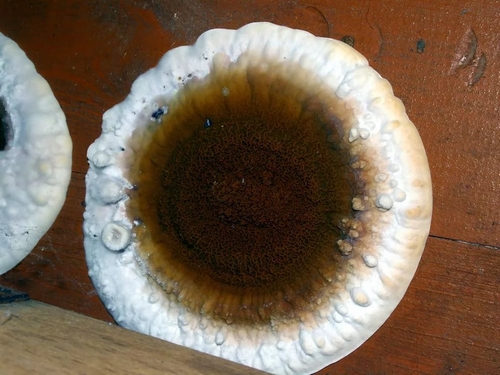

Anna, Terney.
Hello Anna from Terney!
The sickle is crying, but in simple terms - a mushroom house, a terrible thing for wooden structures.
Once it appears, this attack rarely disappears, despite the measures taken. It spreads all the time to new areas of wood and affects them until complete destruction.
The reason may be various factors, but most often it is high humidity in confined spaces, lack of ventilation and ventilation. Contact with previously affected fragments of buildings.
What to do? The first step is to dismantle the floors and structures of the house affected by the fungus in full. Move away from home and the further the better. If possible, burn all affected wood.
Carefully inspect all adjacent wooden areas - floor logs, lower rims of the house (if the house is wooden).
Remove the affected areas or elements completely. Then process the intact wood. In the past, creosote impregnation was used with more or less success. Nowadays, fungicidal impregnations are used more.
But it should be remembered that these modern impregnations, in their toxic properties, are comparable to the harm that a mushroom house brings to a person with its spores. Especially when used in indoor living spaces.
Another means of dealing with this scourge is ultraviolet irradiation with special quartz lamps. The same ones that doctors use, especially in operating rooms, if they have seen any.
After the irradiation, the installation of new floors and replaceable elements is started. With their impregnation with the same creosote (the smell is not very good, but where to go?).
Do not forget about the device of normal ventilation in order to avoid the reappearance of the house mushroom.

Construction in Moscow and Moscow region
A wide range of construction services. Foundation, walls, floors, roof, turnkey!
Other questions about condensation in rooms:
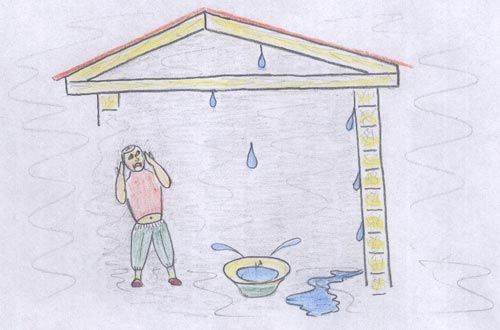
Condensation in the house

Environment
Serpula lacrymans has a preference for temperatures of 21 to 22 ° C (70 to 72 ° F) but can survive any temperature from 3 to 26 ° C (37 to 79 ° F). It is not clear how much light is needed to promote Serpula lacrymans growth. In terms of aeration Serpula lacrymans often grows near ventilation shafts which shows a preference for concentrated oxygen. A moisture content of 30 to 40 percent is its ideal level in wood to promote fruit body formation. It appears that Serpula lacrymans requires an environment where both inorganic and organic materials are present. The fungus uses calcium and iron ions extracted from plaster, brick, and stone to aid the breakdown of wood, which results in.
Effect on wood [| code]
House wall damaged by a mushroom house
According to R. Gartig's research, the destruction of wood occurs partly due to the release of special enzymes by the fungus that dissolve the organic matter of the tree at a considerable distance from the mushroom hyphae and turn them into a form that is digestible by the fungus, partly due to the dissolution of ash constituents (Aschenbestandtheile) cell membranes in places of direct contact of the latter with hyphae.
As the destruction progresses, the tree turns more and more brown and gradually turns into dust; soft when fresh, it becomes dry, brittle, brittle. A floor painted with oil paint is especially easily destroyed by a mushroom house, since the underside of such a floor is protected from light and from drying out.
Presence Merulius lacrymans in such cases, it is recognized by black spots scattered on the upper surface. If the tree is painted with glue paint, then separate fluffy areas of a yellowish color appear on its surface.
Wood infested with house fungus emits a dull sound when tapped, and easily breaks when pressed. The affected tree becomes extremely hygroscopic and eagerly absorbs water like a sponge. In this way, water can be transferred from below to various, often very distant parts of the building, and since the mycelium itself has the ability to easily conduct water and give it to dry wood, the mushroom can make the driest rooms damp and uninhabitable.
To all this must be added the fact that the decaying and rotting fruiting bodies of the fungus emit an extremely unpleasant characteristic odor, harmful to health [clarify].
According to the analyzes of Goeppert and Poleck, the water content in the house mushroom reaches 48 and up to 68%. The fruiting bodies of the D. fungus are formed only where the mycelium comes out into the light and fresh air through a crack or crack.Fruit bodies are lamellar, wide, mostly plate-shaped, sometimes up to a meter in size, fleshy leathery consistency, at first white, then reddish-yellow in places, at the end rusty-brown; from above they are covered with worm-like wriggling folds (there are spores on them), from below they are fibrous-velvety with swollen, as if woblock edges of white color. At the edges of the fruiting body, drops of liquid appear, at first transparent, then cloudy, milky in color (hence the specific name M. lacrymans, that is, crying). Brown or rusty-brown spores are elliptical in shape and very small (0.010 - 0.011 mm in length and 0.005 - 0.006 mm in width). The germination of spores occurs, apparently, only in the presence of substances with an alkaline reaction (ammonia and its salts, potassium carbonate, etc.), which cause the spore shell to swell. In the same sense, urine, ash, coke, etc. substances favor the germination of spores, since they contain or are obtained from alkali-reacting substances.
How the body of serpulida works
The basis of the serpulid organism is a calcareous tube. As they grow older, a new branch of the pipe appears at the end of the old outgrowth.

This family of annelids has been around for over 200 million years.
After some time, the "base" in the form of a tube is overgrown with corals, and the same beautiful Christmas tree remains on the surface. If we consider the structure of the upper "process", then physiologically - these are gill rays. They serve the animal with both the respiratory and digestive systems. It is with the help of these miraculous cilia that the sea worm snatches out small particles of food from the water. And serpulida feeds on unicellular animals and detritus.
Serpulid is called "Christmas trees".
The dimensions of the overcoral part are about 1.5 cm. The diameter of one ring of the herringbone spiral is 2 cm. It is worth noting that the individuals living in the Atlantic Ocean are almost twice as large as their Indo- and Pacific counterparts in the family.
Natural products genes
S. lacrymans' genome encodes six annotated polyketide synthases (PKS1-PKS6), 15 nonribosomal peptide synthetases (NPS1-NPS4, NPS7, NPS13-NPS15, NPS17, and NPS18), and two hybrids thereof (NPS6, NPS8, and NPS16). Additionally, the genome encodes for various putative adenylate-forming reductases (NPS5, NPS9-NPS12) (Eastwood et al., 2011). NPS3 was overexpressed in E. coli and characterized as an atromentin / quinone synthetase that catalyzes the formation of atromentin, similar to GreA; InvA1,2 and 5; and AtrA from Suillus grevillei, Tapinella panuoides, Paxillus involutus, respectively. NPS3 and its adjacent clustered aminotransferase gene (AMT1) were also found to be up-regulated during co-incubation with bacteria (Tauber et al., 2016).
How to protect your home from a mushroom house
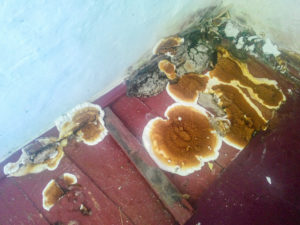
How to recognize a pest

The appearance of a fungus under an oil-painted floor can be detected by the black dots appearing on the floor. And if glue paint was used, then the fluffy yellowish neoplasms that appear will prompt that a "pest" has settled in the house.
It is better to fight the house fungus in the early stages of its appearance. So don't ignore the warning signs. If you see any of the above, go for it!
Conditions conducive to the appearance of fungus
The mushroom house is actively developing in a dark, damp, unventilated room.
- Insufficient ventilation. Hermetically sealed windows, rare ventilation, clogged or walled up ventilation system - all this creates ideal conditions for the development of fungus. This is especially true in the bath and kitchen, where condensation forms.
- Leaking pipes. This leads to increased humidity, which means the appearance of a parasite is possible.
- Freezing of walls, roof leaks, lack of heating - all this also creates moisture.
- Groundwater. They are dangerous for wooden posts and piles in the ground. And they can also lead to the appearance of a fungus in the joints of the walls and the baseboard.
- Painting the floor with oil paint. In this case, the lower part of the boards is deprived of light and the possibility of drying, which means it is prone to fungus.
How to get rid of a mushroom
If, nevertheless, this trouble happened to you, do not despair! Although it is not easy to get rid of this pest, it is possible.
- The area affected by the fungus must be cut out and burned. It must be taken out of the house carefully so as not to spread controversy. The remaining surface must be sanded and rubbed.
- Carry out deep and surface impregnation with fungicidal agents.
- Disinfect the room from fungal spores.
- Identify the cause of the intruder and eliminate it.

Prophylaxis
The spores of the parasite are carried by the wind, so it can get to any of us. Remember, the fungus can appear not only in the old, but also in the newly rebuilt house. However, if we carry out timely prevention, we will save our home from this dangerous pest. Here are the steps you can take.
- Lumber for buildings should be as dry as possible, with a moisture content of no more than 20%. This percentage can be achieved if the tree is naturally dried from January to July.
- Avoid raw materials placed under the floor. Better to use sand or broken brick.
- If you paint the floor with oil paint, then this can only be done after the house is well dry.
- Floors should not be laid tightly against walls.
- It is necessary to create the necessary air draft under the floor.
- Periodically treat wood materials with special impregnations.



